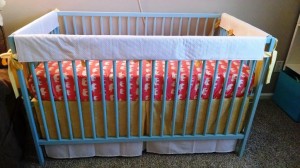It’s easy to forget about our indoor environment when we are trying to be green, but did you know that the indoor air in an average home is 2 to 5 times more polluted than outdoor air? Given the amount of time we all spend indoors, I am always looking for ways to reduce the amount of chemicals in my house; however, there is nothing like preparing for a new baby to make you detoxify your home. My desire to buy eco-friendly products goes into overdrive with the thought of a new little human in the house. Not only do I want to support ethically and environmentally responsible companies, but I want to make sure the products I buy will pose as little risk to human health as possible. And with a new baby comes lots of new product purchases!
When I found out I was pregnant with our second child, I decided to make the nursery as non-toxic as it could be. Sounds easy, right? Wrong! It actually required a ton of online research to figure out exactly what I should avoid. Did I mention I was also on a tight budget? Sometimes buying a better product means spending more money, so I had to prioritize and figure out what changes I could afford to make. One of the things I decided to reduce in the nursery were VOCs (Volatile Organic Compounds). VOCs are chemicals that slowly evaporate, or off-gas, compromising the indoor air quality of your home. According to the EPA, health effects include eye, nose, and throat irritation, headaches, loss of coordination, nausea, damage to the liver, kidney, and central nervous system, and some are suspected or known to cause cancer in animals, including humans. Unfortunately, we live in a chemical world and lots of household products contain VOCs. I wanted to paint both a crib and dresser for the new baby and avoiding VOCs in my painting projects was an easy change to make. Plus, pregnant women are advised to limit exposure to latex paint fumes anyways, so I wasn’t about to do any painting unless I could find an alternative.
I could have opted for a low-VOC or zero-VOC latex paint, which would avoid most (but not all) of the harmful vapors – but there is something even better. Enter milk paint! Milk paint has been around a very long time, you can even make it yourself because the ingredients are so basic. It’s typically made with (you guessed it) milk protein, limestone, clay, chalk, iron oxides for color, and absolutely no VOCs. It’s often used when going for a vintage or distressed look on furniture, but you can use it for just about any job you can think of. I wasn’t going for a distressed look, but I did want something environmentally friendly, so I decided to give it a try.
I wanted a light aqua color for the crib and a happy yellow color for the dresser, and I found the perfect palette with Miss Mustard Seed’s Milk Paint from a local retailer in Virginia Beach, Miss Flibbertigibbet. The crib was unfinished beech wood so it was ready to paint, but the dresser was a used purchase that was already painted white. Another reason milk paint is so great – you don’t need to strip old paint or sand it before putting on new paint! You can add a bonding agent to your milk paint and slap it right on there. It makes updating or upcycling projects even easier. Milk paint comes in powder form and you mix it with water when you are ready to use it, so there is a little bit of a learning curve. For example, you need to make sure it is mixed well or you will end up with chunks at the bottom of your cup that will put streaks in your finished project (lesson learned), but once mixed correctly it’s just like using regular paint. You also need to use a top coat with milk paint – I opted for hemp seed oil on the crib, and a combination of hemp seed oil and furniture wax on the dresser. These top coats are much more environmentally friendly than a laquer (again, think off-gassing), but still protect the paint and give it a nice sheen. Check out the photos of my finished products!

The finished dresser painted in “Mustard Seed Yellow” mixed with a little “Ironstone” to lighten it up a bit.
Another reason I love milk paint is storage and disposal. Paints are normally classified as Household Hazardous Waste (HHW), and should be disposed of at HHW disposal facility, due to all of the chemicals present. You can’t pour it down the drain or put it out with your trash. Pouring it down a household drain will send it to a HRSD wastewater treatment plant, which is not designed to remove many of the chemicals in paint and other household products. Milk paint, on the other hand, has an infinite shelf life when left in its powder form, so whatever you don’t use can be sealed back up for the next project and you don’t need to worry about it creating a hazardous storage area in your garage. Once you have mixed the paint with water, any leftovers can go out with your trash.
I hope this encourages you to green your own indoor space. Don’t be afraid to give milk paint a try, and remember to always dispose of household chemicals properly.

